- Video Production
- Video Production Equipment for Beginners
- DIY Camera Stabilizer
DIY Camera Stabilizer: Make Steady Videos with Gear You Already Have
Not all DIY camera stabilizer devices are built.
Key Takeaways: DIY Camera Stabilizer
Leverage Existing Gear: Achieve stable footage without purchasing specialized equipment by creatively repurposing items like camera straps, tripods, monopods, and even a garter string.
Camera Strap Techniques:
- Use the strap around your neck or shoulder to create tension for stability during handheld shots.
- Step on the strap for low-angle shots or hang the camera for minimal slider/crane-like movements.
Tripod Hacks:
- Convert a tripod into a monopod by extending one leg.
- Create a shoulder rig by resting tripod legs on your shoulders for balanced weight distribution.
- Simulate dolly or slider shots by moving the tripod on a blanket or pulling it across a smooth surface.
Monopod Flexibility: Pair a monopod with a camera strap as a shoulder rig for dynamic, on-the-go shooting.
Garter String Stabilizer: Attach a garter to your tripod plate for controlled crane-like movements by stepping on the string ends.
Pro Tip: Disable in-camera/image stabilization (IBIS/IS) for a raw, documentary-style look when using shoulder rig setups.
Context Matters: DIY methods excel for casual or beginner projects, though professional gear remains superior for demanding shoots.
Relevance: With 82% of internet traffic being video, mastering affordable stabilization techniques is crucial for content creators.
Are you looking for ways to improve the quality of your shots without spending so much? No fancy tools required. But very handy for beginners.
In this article, we're not going to talk about buying raw materials, and making your own camera stabilizer.
Why?
Because, honestly, it's better and more convenient to buy a low-cost, ready-made, but properly designed stabilizer. Not everyone wants to go through the hassle of sourcing materials, and building a camera stabilizer by trial and error.
So...
We'll only focus and talk about some free, alternative ways of stabilizing your camera as you're shooting videos. Using gear or tools you may already have.
What are DIY camera stabilizers?
DIY camera stabilizers are homemade or repurposed tools that reduce shaky footage by keeping your camera steady while filming, offering an affordable alternative to professional stabilizers.
Okay, let's clarify first what "DIY camera stabilizer" is. As you can see, it is the combination of...
... "DIY" + "camera stabilizer".
"DIY" means "do it yourself".
And "camera stabilizer" refers to any tool you use to make your camera stable, while you're shooting videos.
Ever record a video and end up with shaky footage? It happens to me as well! A camera stabilizer smooths out all those bumps and jitters, so your videos look polished and pro.
So, a "do-it-yourself camera stabilizer" is different from a dedicated or branded camera stabilizer. A DIY camera stabilizer is an alternative device for making your camera stable while you're shooting.
But wait! Not everyone has the time or tools to build a stabilizer from scratch. That's okay! There are many ways to achieve stable footage using gear you might already have.
You can categorize DIY camera stabilizers into two groups...
- devices that you build yourself using various raw materials, and
- existing gear that you repurpose to be used in other creative ways of keeping your camera steady.
This article focuses on the second group.
Crazy stat alert! Cisco says a whopping 82% of internet traffic is videos. No wonder everything feels like video these days! Wild, right?
This means more and more people are creating their own videos, like vlogs and stuff for social media. And guess what? That makes learning some simple video stabilization tricks super helpful for beginners!
That's where DIY video stabilization comes in – perfect for affordable, high-quality content!
How do you use a camera strap as a DIY camera stabilizer?
The Core Principle: Pull the strap tight to create tension, stabilizing your camera against your body.
Simple Methods for Beginners:
- Around the Neck:
- Wear the strap normally.
- Extend your arms fully, pulling the camera away from your neck (creating tension, but not painfully tight).
- Shoot with your elbows tucked in slightly. This tension minimizes shake for handheld shots and pans/tilts. - Over the Shoulder (Sling Style):
- Slip the strap over one shoulder so the camera hangs at your side/hip.
- Bring the camera up in front of you with both hands.
- Pull the camera away from your body, tightening the strap over your shoulder. This anchors the camera. - Stepping on the Strap (Low Shots):
- Stand with one foot firmly on the middle of the strap.
- Hold the camera with both hands and pull upwards gently against the strap's tension.
- Shoot from this stable, low position.
Key Tips for All Methods:
- Tension is Key: The stabilizing effect comes from pulling against the strap's anchor point (your neck/shoulder/foot).
- Minimize Movement: Walk slowly and avoid big, jerky motions for best results. Smooth pans/tilts work well.
- Check Length: Adjust the strap so it's comfortable when pulled taut for your shooting position.
- Safety First: Don't pull so hard it hurts your neck or risks dropping the camera. Ensure the strap connections are secure.
In short: Anchor the strap (on neck, shoulder, or foot), hold the camera, and pull to create tension. This simple hack adds stability instantly!
Most likely, you also got a camera strap, when you bought your camera. The strap can be your best friend, because it's always there, to help you quickly stabilize your camera.
It's so handy. :-)
Here's some ways of using the camera strap as camera stabilizer...
- Camera strap around your neck.
- Camera strap hanging on your shoulder, like a sling bag.
- Stepping on the camera strap.
- Hanging your camera and lens on the strap.
Now, let's take a closer look at each method...
1. Camera strap around your neck.
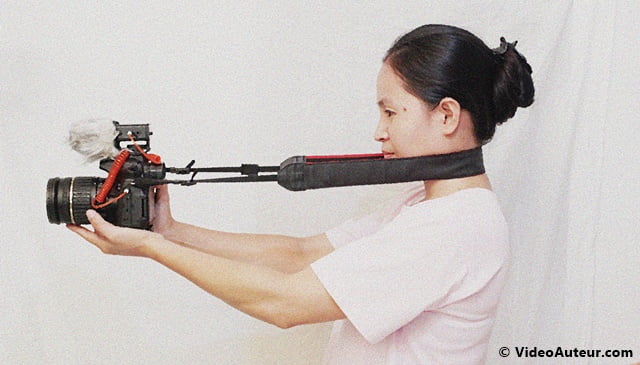 DIY camera stabilizer: Using camera strap as stabilizer
DIY camera stabilizer: Using camera strap as stabilizer- Wear the camera strap around your neck.
- Make sure that strap length matches the length of your arms. Not too long, not too short. And your eyes can clearly and comfortably see the camera screen.
- Hold the camera in a manner that you're pulling it away from you. But not too tight, to avoid hurting the back of your neck. This will help you record stable shots.
- With your arms extended, pulling the camera strap tight enough, start shooting and doing camera movements—like panning and tilting.
2. Camera strap hanging on your shoulder, like a sling bag.
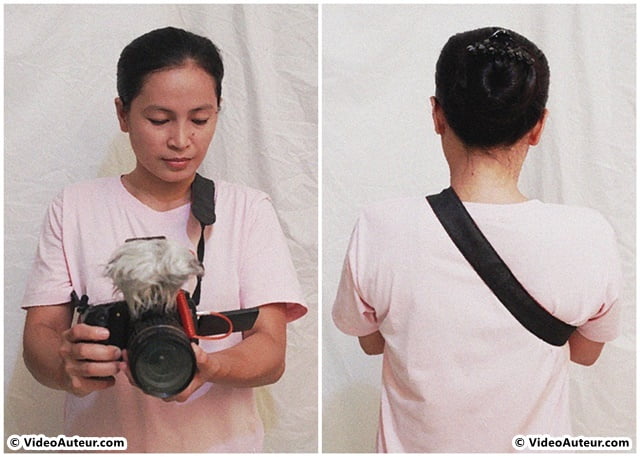
- This method is similar to, "camera strap around your neck". But this time, you're wearing the camera and its strap, like a sling bag.
- Position your camera to the front.
- Hold the camera, pulling it away from you.
- Start shooting and executing camera movements.
3. Stepping on the camera strap.
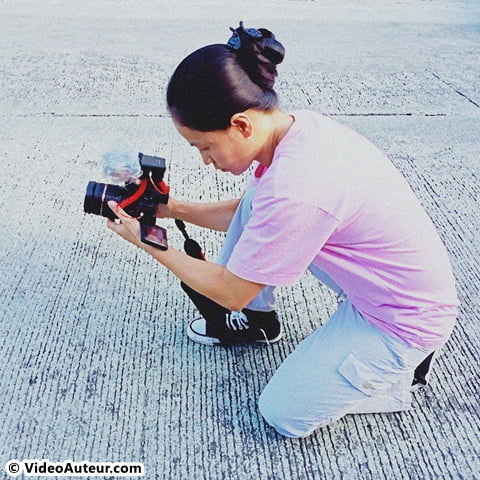
- This technique helps stabilize your shots, from a low angle.
- Step on the camera strap with one foot, while holding the camera with both hands.
- Pull the camera upwards and start shooting.
4. Hanging your camera and lens on the strap.
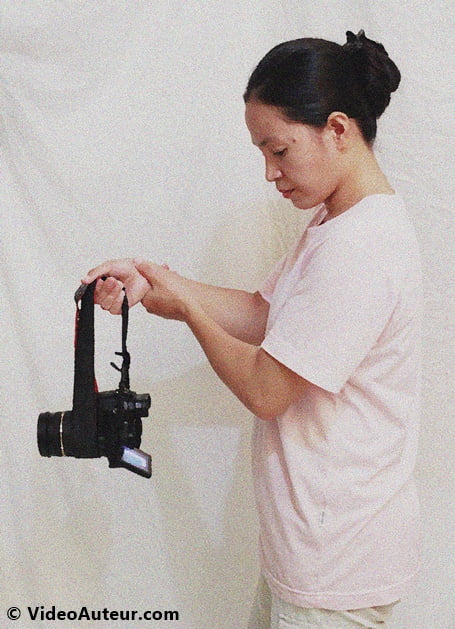
- This method works better, if you apply it to a fairly heavy camera—like a DSLR with wide angle zoom lens. Because the heavier the weight of camera-lens combination, the better the stabilization.
- You'll find it easier to use this technique, if your camera has a swiveling screen. Because you can see your framing well, while making your shots.
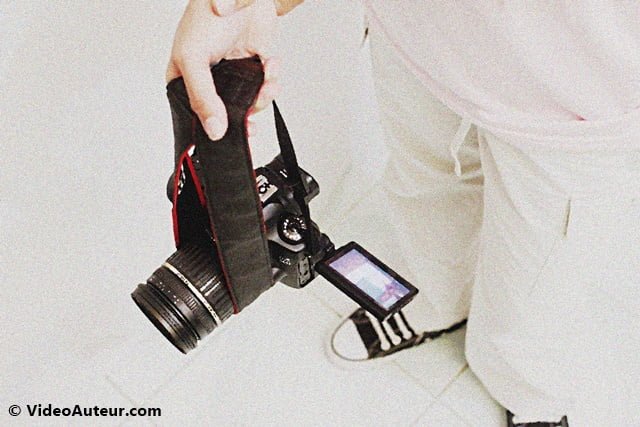
- For better and realistic results, I recommend this technique, only if you're going to do minimal camera movements. Such as small slider-like, or crane-like movements. I don't recommend this for extended walking and running shots—like when using a steadicam, or a gimbal.
- To use this method, both ends of the camera strap need to be attached to the camera body. Then, wrap the middle of the strap under the lens.
- Ensure that camera strap is not touching the lens focus ring. Because you don't want the strap to interfere with focusing, when you're shooting.
- Now, carry your camera like a hand bag. Press the record button, and start shooting. Remember—"minimal camera movements", only.
How can I use a tripod in unconventional ways to create a DIY camera stabilizer?
- Monopod Hack: Extend only one tripod leg fully and collapse the other two. Hold it like a single-leg monopod for quicker height adjustments and basic stabilization while moving.
- Simple Shoulder Rig (Version 1): Collapse all 3 tripod legs. Rest them on one shoulder. Hang the camera strap around your neck, adjust for viewing comfort, then hold the camera/tripod away from you with both hands while filming.
- Dolly-like Shots: Stand the tripod normally. Position one leg pointing directly towards you. Gently push the tripod forward ("dolly in") or pull it towards you ("dolly out") while holding that leg, creating a small rising/falling movement.
- Blanket Slider: Place a blanket on a smooth indoor floor. Put the tripod (with camera mounted) on the blanket. Press record and slowly pull the blanket across the floor to create smooth sliding shots.
Key Beginner Tips:
- These are quick, budget-friendly alternatives to professional gear.
- Focus on the monopod and simple shoulder rig methods first – they're the easiest.
- For the blanket slider, ensure the floor is very smooth.
- Practice movements slowly for smoother results.
Can I use a tripod as a stabilizer?
Yes. That's my quick answer. :-)
But, we'll only talk about alternative ways of using the tripod, as camera stabilizer. Ways that are more sensible, more effective, and easier to do, in the real world.
How to use a tripod as a stabilizer?
- Use tripod as a monopod.
- Use tripod and camera strap as shoulder rig.
- Use tripod like a dolly, or to get dolly-like shots.
- Use tripod and blanket as slider.
Let's take a closer look at each method...
1. Use tripod as a monopod.
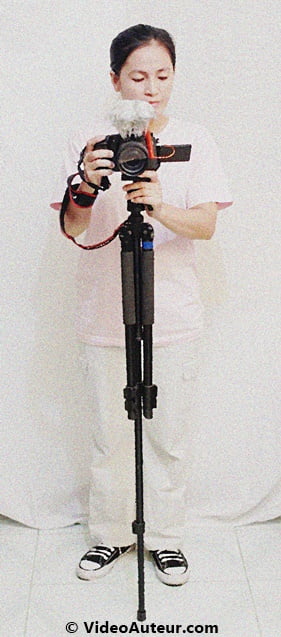
This is what I love about the monopod...
I only have to adjust one leg—just one leg—and I can go on shooting my subject from different angles.
What a huge time saver!
I can even incorporate minimal camera movements, and my monopod shots still look great. Very convenient to use.
In other words, a monopod helps a lot when shooting real life events. When you cannot afford to miss capturing precious life moments.
Hey, what if I don't have a fancy one-legged camera stand (monopod), but I do have a regular tripod? Can I just use the tripod like a monopod in a pinch?
Yes. Here's how...
- Extend only one tripod leg, all the way.
- Keep the other 2 legs collapsed, or closed up.
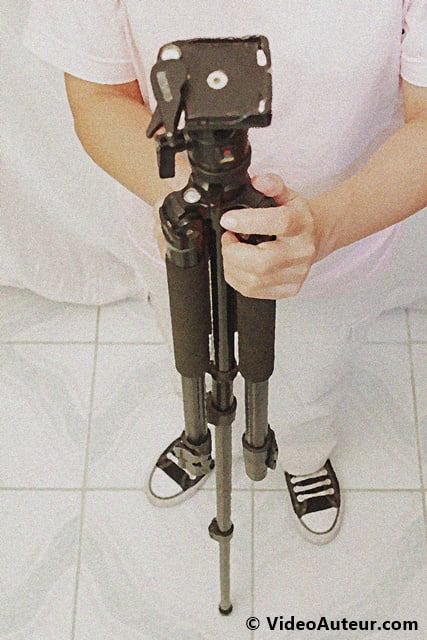
- Use that one extended tripod leg as a monopod, when shooting. Treat the other 2 legs, as if they don't exist.
- Now, you only have one leg to adjust—say, when you want to shoot from a low angle.
2. Use tripod and camera strap as shoulder rig.
When you watch news on TV, do you notice those raw, unpretentious, but still decent-looking handheld shots?
Those shots usually result from carrying a big, heavy broadcast camera. The camera operator puts the videocam on his—or her shoulder, and moves to where the action is happening, while shooting.
You can also get that similar resulting look. Even though, you're using a relatively lighter camera—like a DSLR, a mirrorless camera, or a small camcorder.
But how?
- By mounting your camera on a tripod.
- And using that tripod and the camera strap as shoulder rig.
—
There are 2 ways of using a tripod and a camera strap as shoulder rig...
Version 1: All 3 tripod legs on just one shoulder.
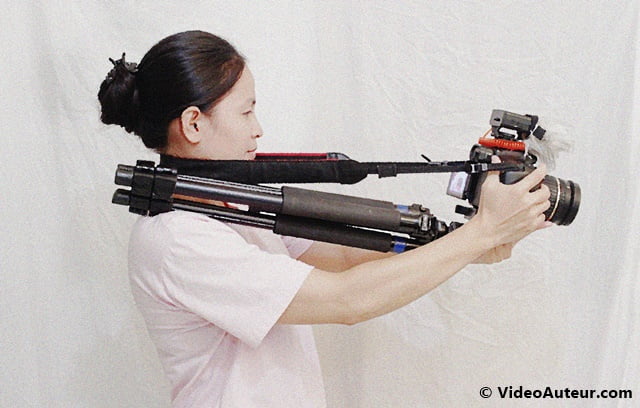 How to use a tripod as a stabilizer?
How to use a tripod as a stabilizer?This tripod-camera strap combination as shoulder rig, is easy to set up. Especially when you're shooting events. Here's how...
- Collapse all 3 tripod legs.
- Place the 3 tripod legs on your right shoulder—if you're right-handed. (Or, on your left shoulder—if you're left-handed.)
- Hang the camera strap from your neck. Position the camera in a way that you can clearly, and comfortably see the screen. Adjust the strap length as you do this.
- Now, all 3 tripod legs are resting on your shoulder. Next, pull the camera away from you with your 2 hands, without hurting the back of your neck.
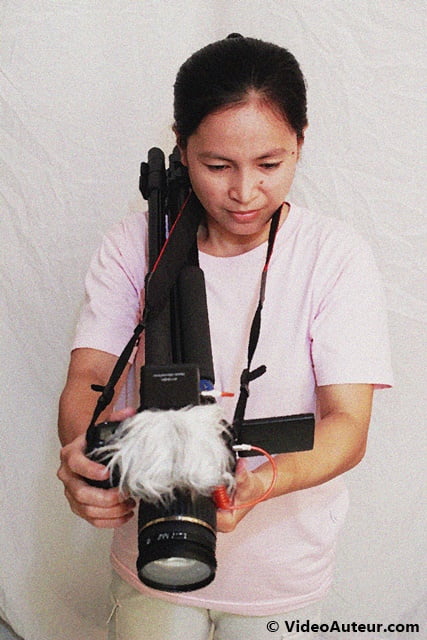
- Then, start shooting.
—
Version 2: 2 tripod legs on both shoulders.
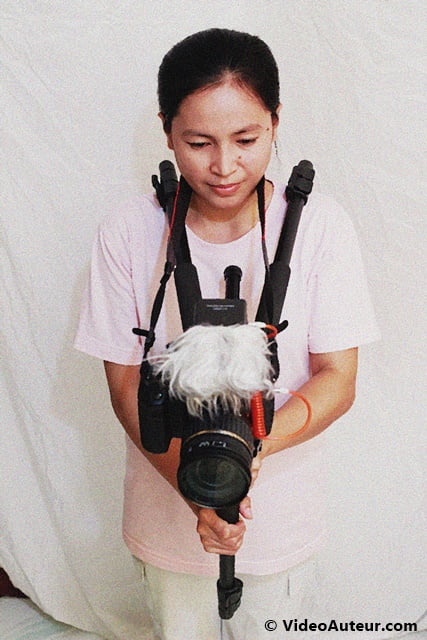
This is not as easy to set up as "version 1". But "version 2" is better for your shoulders, because of the equally distributed weight of tripod legs.
I prefer to use version 2 of tripod-camera strap as shoulder rig, when shooting in more controlled environments—like in studios. I also like using "version 2", when shooting more structured presentations—say, a scripted short film, or a music video.
Here's how to do "version 2" of using a tripod and a camera strap, as shoulder rig...
- Collapse all tripod legs but place the 2 legs on your left and right shoulders (as shown in the picture above).
- Hang the camera strap from your neck. Position the camera in a way that you can clearly, and comfortably see the screen. Adjust the strap length as you do this.
- Now, the 2 tripod legs are resting on your shoulders. Next, press the "record" button.
- Then, hold the one remaining tripod leg with your 2 hands. Pull it firmly away from you, without hurting the back of your neck.
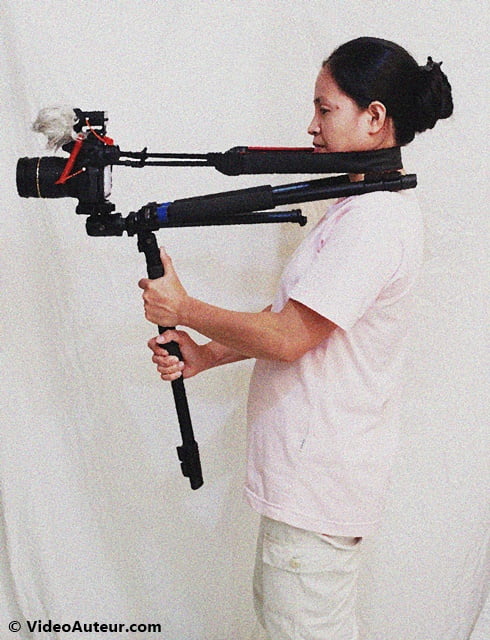
- Start shooting.
Tip: If your lens has Image Stabilization—or, IS—turn it off. If your camera has in-body image stabilization—or IBIS—turn it off as well.
Why?
You'll get a more natural, rawer, and more documentary feel to your shoulder rig shots.
3. Use tripod like a dolly, or to get dolly-like shots.
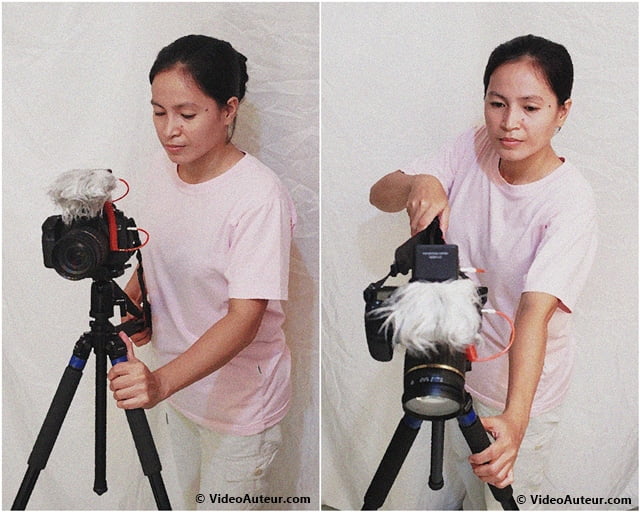
I'd like to emphasize, "dolly-like". Because this alternative way of using a tripod, only gives a look similar to the authentic dolly shot.
A dolly shot is a smooth sideways, forward, or backward movement of the camera. A cinematographer uses a cart with wheels—or something that moves on a rail track—to do a dolly shot.
With a real dolly, you can get the look of a camera moving fluently, along a straight line.
But, using a tripod as a dolly, gives you a look where the camera rises a little, and then moves downward.
So how do use a tripod like a dolly?
- Mount your camera on a standing tripod.
- Position the tripod legs, in a way that one leg is directly pointing towards you.
- Hold that one tripod leg, and carefully do some "dolly in" and "dolly out" shots. (You "dolly in", when you push the tripod forward. You "dolly out", when you pull the tripod toward you.)
4. Use tripod and blanket as slider.
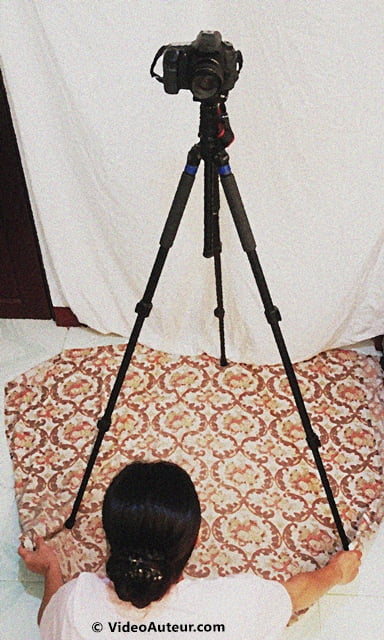
I prefer to do this technique...
- indoors,
- on a smooth floor, and
- in a controlled environment.
Why?
To easily execute and get the slider effect.
Here's how to do it...
- Place a blanket on a smooth floor.
- Place the tripod on that blanket and mount your camera on the tripod.
- Consider how you'll film your subject, using this technique. Know the start and the end of your improvised slider shot.
- Press the "record" button, and slowly pull the blanket across the floor, to do your slider-like shot.
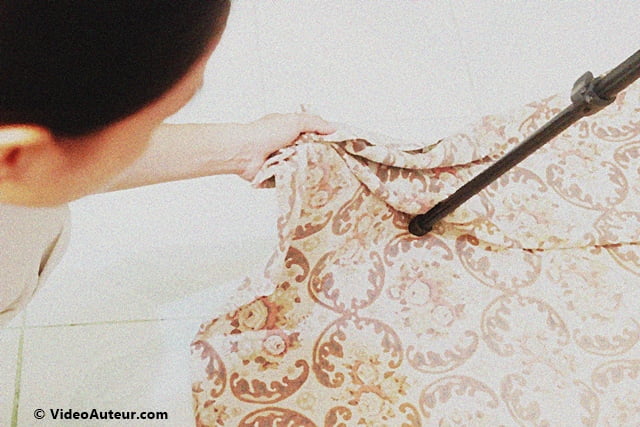
How can I create a DIY camera stabilizer using a monopod and a camera strap to function as a shoulder rig?
Here's a concise, step-by-step guide for beginners using a monopod and camera strap as a DIY shoulder rig:
- Requirement: Ensure your monopod has a tilt head.
- Mount: Attach your camera securely to the monopod's tilt head.
- Collapse: Shorten the monopod legs fully.
- Position:
- Put your camera strap around your neck.
- Rest the bottom end of the collapsed monopod firmly on your dominant shoulder (right if right-handed, left if left-handed). - Adjust:
- Tilt the monopod head to position the camera so you can see its screen clearly and comfortably.
- Adjust the strap length as needed during this step. - Shoot:
- Gently pull the camera away from your body with both hands (holding the camera/monopod).
- Keep the monopod base anchored on your shoulder and the strap snug (but not choking) on your neck.
- Start recording.
Key Takeaway: The strap takes the main weight off your arms, while the monopod leg on your shoulder and your hands pulling forward create a stable, three-point contact (shoulder, neck/strap, hands).
Adjust the tilt head and strap length for comfort and visibility.
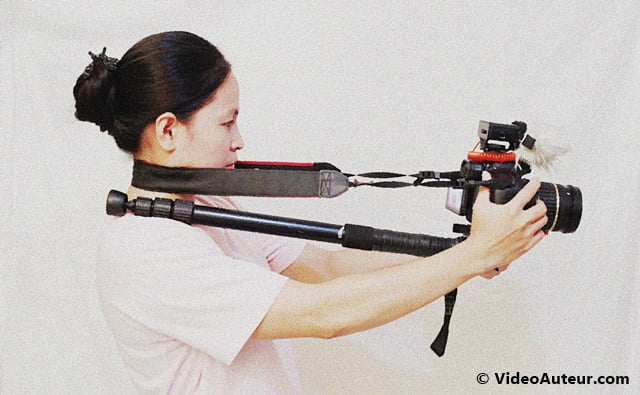 DIY camera stabilizer: Using monopod and camera strap as shoulder rig
DIY camera stabilizer: Using monopod and camera strap as shoulder rigThis technique is similar—in fact—almost identical with, "using tripod and camera strap as shoulder rig".
The only difference? You got it—we're using monopod, instead of tripod.
Note: This works if your monopod has a tilt head.
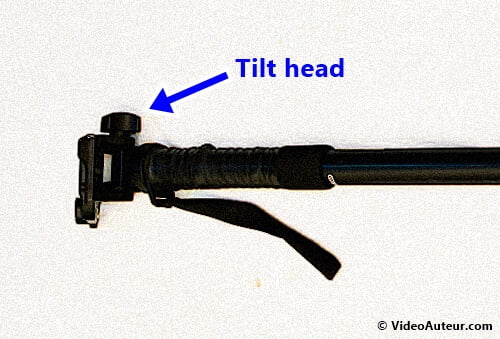 The tilt head allows you to use the monopod as shoulder rig.
The tilt head allows you to use the monopod as shoulder rig.So, how do we use monopod and camera strap as shoulder rig?...
- Mount your camera on the monopod's tilt head.
- Collapse the monopod leg.
- Hang the camera strap from your neck. Then, place the monopod leg on your right shoulder—if you're right-handed. (Or, on your left shoulder—if you're left-handed.)
- Adjust the tilt head to position the camera, in a way that you can clearly, and comfortably see the screen. Adjust the strap length, as you do this.
- Now, the monopod leg is resting on your shoulder. Next, pull the camera away from you with your 2 hands, without hurting the back of your neck.
- Start shooting.
How can I make a cheap/DIY camera stabilizer using readily available materials like garter string and a tripod plate to reduce camera shake and get smoother footage?
Here's a concise, step-by-step guide for beginners on making the DIY stabilizer using a garter string and tripod plate:
- Attach the Plate: Screw your camera's tripod mounting plate onto the camera bottom (like you would for a tripod).
- Thread the String: Push one end of a sturdy garter string (elastic cord) through the metal ring/hole on the tripod plate.
- Step and Stabilize: Stand with your feet shoulder-width apart and step firmly on both loose ends of the string on the ground.
- Hold and Lift: Hold the camera firmly by its body (don't hold the string). Lift it slightly to create tension in the string.
- Shoot Smoothly:
- For an UP shot (Crane Up): Slowly and steadily pull the camera straight upwards while filming. Let the stretched string stabilize the movement.
- For a DOWN shot (Crane Down): Start with the camera held high and string taut. Slowly and steadily lower the camera, letting the tensioned string control the descent while filming.
Key Tip for Beginners: Focus on moving the camera very slowly and at a consistent speed up or down. This slow, steady motion + the string tension is what creates the smooth footage and reduces shake.
Practice without recording first!
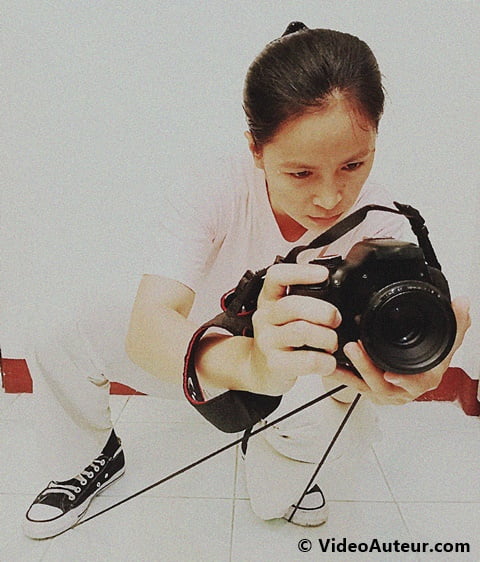 DIY camera stabilizer: Using garter string and tripod plate to stabilize camera movement
DIY camera stabilizer: Using garter string and tripod plate to stabilize camera movementA garter string can come in handy, as another form of camera stabilizer, when you're already using a tripod.
How?
Remember that to use a tripod, you need to attach the tripod plate under the camera body. So, you can mount the camera on a tripod.
But...
This alternative way of stabilizing camera movements will only need...
- the tripod plate already attached to camera body, and
- a garter string.
Here's how to do it...
- Simply insert the garter string into the ring of the plate screw.
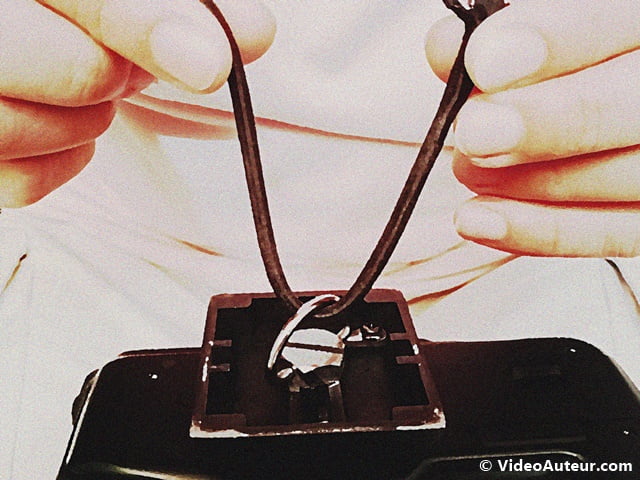
- Now, how you use the garter string and the tripod plate, will depend on the camera movement you want to do.
- Let's say you want some crane-like motion. To do it, step on both ends of the garter string.
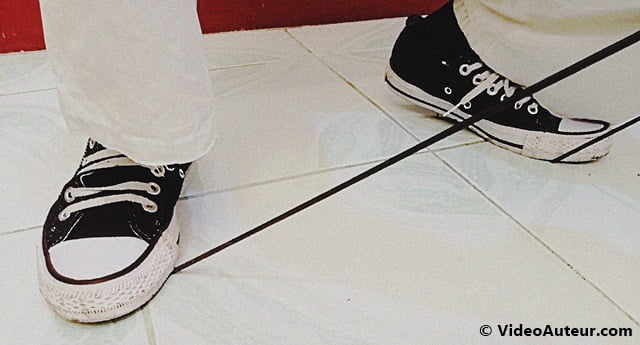
- Press the record button.
- To do a "crane up" shot, slowly pull the camera up while filming your subject. (Doing this will stretch the garter string, of course. So, try to do this at a consistent speed.)
- Now, try to do the opposite—a "crane down" shot. With the garter string already stretched, slowly let the camera be pulled down by the garter string, while filming your subject. (Again, try to do this at a consistent speed.)
It's important to note that these DIY methods may not be as effective as high-end, store-bought stabilizers, especially for long shoots or demanding situations. However, they're a great way to get started and improve your videography skills without a significant investment.
FAQs: DIY Camera Stabilizer Ideas and Alternatives
What are DIY camera stabilizers? (For phones and cameras)
What are DIY camera stabilizers? (For phones and cameras)
DIY camera stabilizers are simple, homemade tools or rigs you can build yourself to help keep your phone or camera steady while filming.
Instead of buying expensive gear, you can use common household items—like PVC pipes, weights, or even rubber bands and hammers—to reduce shaky footage and get smoother shots.
These stabilizers work for both smartphones and regular cameras and are perfect if you're on a budget or just starting out.
How do I stabilize my camera without any special equipment?
How do I stabilize my camera without any special equipment?
You can stabilize your camera easily without buying anything special. Here are some handy tips:
- Use a solid surface: Place your camera or phone on a stable table, wall, or even a rock if you're outside.
- Make your body a stabilizer: Tuck your elbows into your sides, spread your legs a bit for good balance, and gently press the shutter after you finish exhaling.
- Use your camera strap: Pull the strap tight against the back of your neck while you hold the camera in front. This creates tension and steadies your shot.
How do you hold the camera to minimize shaky movement?
How do you hold the camera to minimize shaky movement?
To keep things steady, hold your camera like this:
- Use both hands: One hand grips the camera body, the other supports the lens from below.
- Tuck your elbows: Keep your elbows close to your body for stability.
- Stand stable: Spread your feet hip-width apart and, if possible, lean against a wall or solid object.
How can I stabilize my camera without a tripod?
How can I stabilize my camera without a tripod?
No tripod? No problem! Try these tricks:
- Rest your camera on a sturdy object like a table, shelf, or even a backpack.
- Use a beanbag or rice bag: Place your camera on one to absorb small movements and steady your shot.
- Make a string tripod: Tie string to your camera, step on it to create tension, and pull up gently for extra support.
- Lean against a wall or tree to steady yourself.
How can I use a tripod as a DIY camera stabilizer?
How can I use a tripod as a DIY camera stabilizer?
Your tripod can become an impromptu stabilizer—even when not set up on the ground:
- Hold the tripod horizontally: With your camera attached, hold the tripod by the legs and let its weight counteract small shakes.
- Use as a monopod: Extend just one leg and brace it lightly on the ground for more mobility while still reducing shakes.
- Center column hack: Hold your tripod by the center column and let the weight help stabilize your shot.
Conclusion
There you have it! With a little creativity and these handy DIY methods, you can achieve surprisingly stable footage using gear you already own.
Remember, these DIY methods are a great way to achieve stable footage without breaking the bank.
So, grab your camera, pick a method that suits your needs, and get ready to shoot some amazing videos!
To learn about some dedicated camera stabilizers, check out these related topics on...







